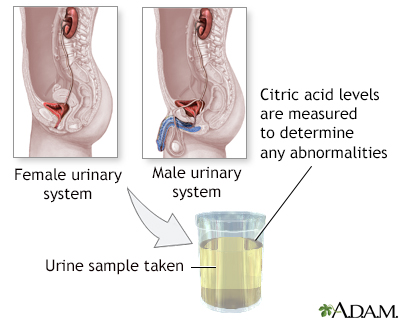Citric acid urine test
Urine - citric acid test; Renal tubular acidosis - citric acid test; Kidney stones - citric acid test; Urolithiasis - citric acid test
Citric acid urine test measures the level of citric acid in urine.
Images

I Would Like to Learn About:
How the Test is Performed
You will need to collect your urine at home over 24 hours. Your health care provider will tell you how to do this. Follow instructions exactly so that the results are accurate.
How to Prepare for the Test
No special preparation is necessary for this test. But the results are affected by your diet, and this test is usually done while you are on a normal diet. Ask your provider for more information.
How the Test will Feel
The test involves only normal urination, and there is no discomfort.
Why the Test is Performed
The test is used to diagnose renal tubular acidosis and evaluate kidney stone disease.
Normal Results
The normal range is 320 to 1,240 mg per 24 hours.
Normal value ranges may vary slightly among different laboratories. Some labs use different measurements or test different samples. Talk to your provider about the meaning of your specific test results.
What Abnormal Results Mean
A low level of citric acid may mean renal tubular acidosis and a tendency to form calcium kidney stones.
The following may decrease urine citric acid levels:
- Long-term (chronic) kidney failure
- Diabetes
- Excessive muscle activity
- Medicines called angiotensin converting enzyme (ACE) inhibitors
- Parathyroid glands do not produce enough of its hormone (hypoparathyroidism)
- Too much acid in the body fluids (acidosis)
The following may increase urine citric acid levels:
- A high carbohydrate diet
- Estrogen therapy
- Vitamin D
Risks
There are no risks with this test.
Related Information
Proximal renal tubular acidosisRenal
Acidosis
Hypoparathyroidism
Diabetes
Chronic kidney disease
Carbohydrates
Vitamin D
References
Dixon BP. Renal tubular acidosis. In: Kliegman RM, St. Geme JW, Blum NJ, Shah SS, Tasker RC, Wilson KM, eds. Nelson Textbook of Pediatrics. 21st ed. Philadelphia, PA: Elsevier; 2020:chap 547.
Oh MS, Briefel G, Pincus MR. Evaluation of renal function, water, electrolytes, and acid-base balance. In: McPherson RA, Pincus MR, eds. Henry's Clinical Diagnosis and Management by Laboratory Methods. 24th ed. Philadelphia, PA: Elsevier; 2022:chap 15.
Pearle MS, Antonelli JA, Lotan Y. Urinary lithiasis: etiology, epidemiology, and pathogenesis. In: Partin AW, Dmochowski RR, Kavoussi LR, Peters CA, eds. Campbell-Walsh-Wein Urology. 12th ed. Philadelphia, PA: Elsevier; 2021:chap 91.
BACK TO TOPReview Date: 10/31/2021
Reviewed By: Walead Latif, MD, Nephrologist and Clinical Associate Professor, Rutgers Medical School, Newark, NJ. Review provided by VeriMed Healthcare Network. Also reviewed by David Zieve, MD, MHA, Medical Director, Brenda Conaway, Editorial Director, and the A.D.A.M. Editorial team.

Health Content Provider
06/01/2025
|
A.D.A.M., Inc. is accredited by URAC, for Health Content Provider (www.urac.org). URAC's accreditation program is an independent audit to verify that A.D.A.M. follows rigorous standards of quality and accountability. A.D.A.M. is among the first to achieve this important distinction for online health information and services. Learn more about A.D.A.M.'s editorial policy, editorial process and privacy policy. A.D.A.M. is also a founding member of Hi-Ethics. This site complied with the HONcode standard for trustworthy health information from 1995 to 2022, after which HON (Health On the Net, a not-for-profit organization that promoted transparent and reliable health information online) was discontinued. |
The information provided herein should not be used during any medical emergency or for the diagnosis or treatment of any medical condition. A licensed medical professional should be consulted for diagnosis and treatment of any and all medical conditions. Links to other sites are provided for information only -- they do not constitute endorsements of those other sites. © 1997- 2024 A.D.A.M., a business unit of Ebix, Inc. Any duplication or distribution of the information contained herein is strictly prohibited.
